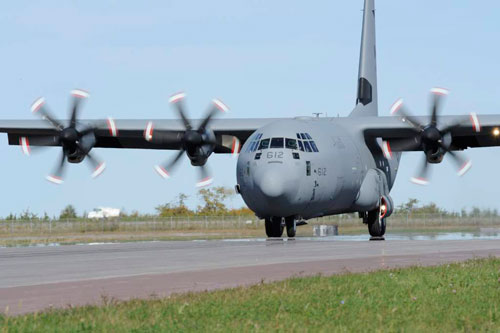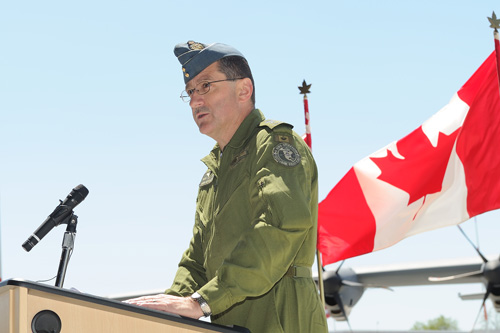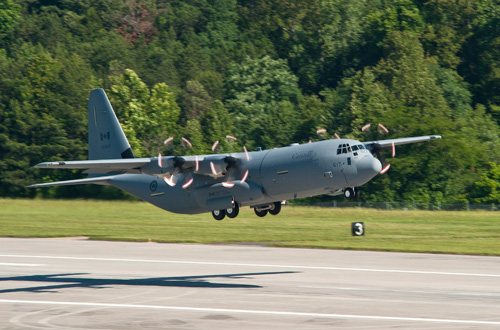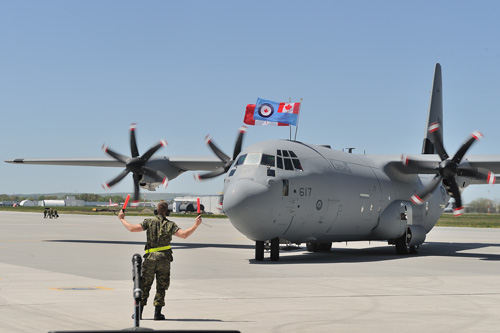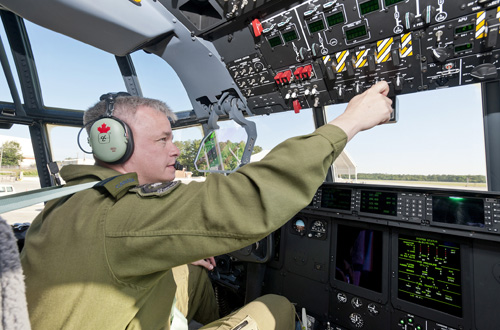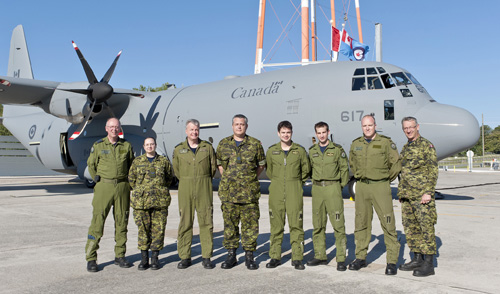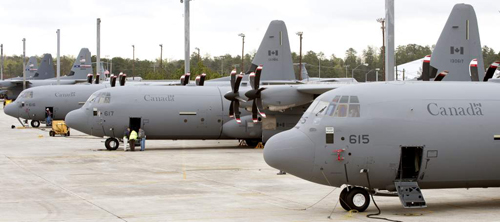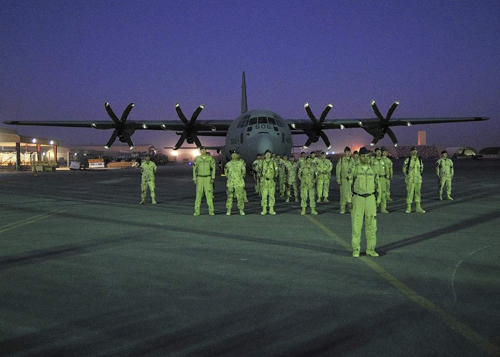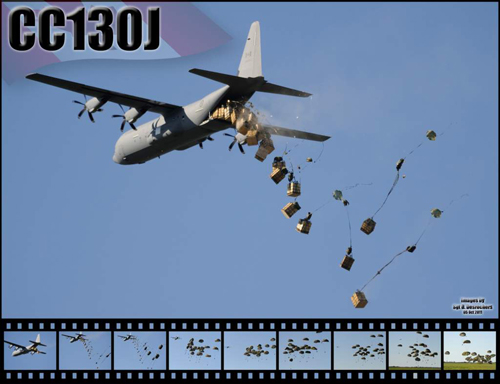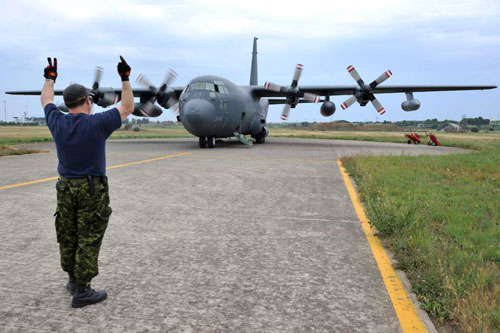CC-130J Hercules tactical airlift procurement project
Project summary
The Government of Canada procured 17 tactical transport aircraft to replace the legacy E-model Hercules that were nearing the end of their operational life. The final aircraft was delivered in May 2012, on budget and six months ahead of schedule and has been operational since December 2010. The acquisition contract is worth $3.1 billion. In-service support is ongoing.
The new CC-130J Hercules has already been effectively integrated into Canadian Armed Forces’ operations. It is the workhorse of the Canadian Armed Forces’ transport fleet and provides support to joint operations at home and overseas. CC-130J Hercules aircraft quickly and safely carry passengers, heavy equipment and supplies over long distances to support operations, or in response to crises, such as natural disasters.
On the outside the CC-130J looks almost identical to the older Hercules, but internally the J-model Hercules is essentially a completely new aircraft. The new aircraft fly faster, higher and farther, and carry heavier loads while burning less fuel. They can use shorter landing and take-off fields, and their climb time is reduced by up to 50 percent compared to the older models..
Project phases

Currently in Phase 5: Close-out
1. Identification
1. Identification
- September 22, 2005
2. Options analysis
2. Options analysis
- November 21, 2005
3. Definition
3. Definition
- June 22, 2006
4. Implementation
4. Implementation
- Request for proposal: August 2007
- Project approval implementation: December 13, 2007
- Contract award: December 20, 2007
- First delivery: June 2010
- Initial operational capability: September 23, 2013
- Full operational capability: February 2019
5. Close-out
5. Close-out
- Effective project close-out: 31 March 2019
- Project close-out: September 2022
Learn more about the Defence procurement process.
Additional information
Project updates
Project updates
Ongoing
The CC-130Js support Operation IMPACT, the ongoing Canadian Armed Forces’ contribution to the fight against ISIL.
The aircraft participate in domestic evacuations, such as the efforts to evacuate the First Nations community of Kashechewan, Ontario in 2014 or to respond to the wildfire situation in Fort McMurray in 2016.
Annually
The CC-130Js provide airlift support throughout Canada and especially in the Arctic in support of the annual Operation NANOOK.
September, 2018
Modification of the CC-130J fleet with the 7.1/ADS-B upgrade completed.
December 1, 2017
Test and evaluation of the 7.1/ADS-B upgrade began.
November 30, 2017
The first aircraft was modified with the 7.1/ADS-B.
July 24, 2017
New Electronic Warfare Simulator were declared ready for use.
December 20, 2016
A standalone version of the electronic technical documentation management system was delivered to 436 Squadron.
December 2, 2016
A contract for an integrated Automatic Dependent Surveillance Broadcast (ADS-B) system is awarded to LM.
October 2016
The latest aircraft upgrade program was completed with the successful delivery of the seventeenth aircraft.
April 2016
The contract with Lockheed Martin is amended to update the fleet’s software to meet emerging North American Airspace navigation requirements.
March 2016
Textron Systems wins a contract for an electronic warfare threat stimulator. This stimulator will increase the performance of the CC-130J self-defense system. The self-defense system detects the launch of hostile anti-aircraft missiles and dispenses chaff and flares to defeat the missile.
December 2015
Lockheed Martin wins a five-year contract extension for in-service support.
August 2014
The CC-130J fleet began assistance for Op IMPACT in Iraq/Syria.
March 2014
CAE wins a contract amendment for updates to the CC-130J training program. The contract amendment is valued at $36.7 million.
November 2013
The CC-130Js support humanitarian relief efforts with the mobilization of Canada’s Disaster Assistance Response Team (DART) after Typhoon Haiyan struck the Philippines.
Lockheed Martin wins a contract amendment to modify the fleet to meet increased worldwide airspace requirements.
May 2012
All 17 aircraft are delivered on time and on schedule.
February 2011
The CC-130Js are involved in the initial evacuation of Canadians from Libya.
January 2011
The first CC-130J arrives in Kandahar. CC-130Js are deployed on Operation ATHENA, Canada’s contribution to the allied mission in Afghanistan.
December 2010
The fleet undertook its first operational deployment to Afghanistan in support of Op ATHENA.
June 2010
The first two CC-130J Hercules are welcomed into RCAF’s fleet, six months ahead of the initial delivery schedule.
February 2010
The contract was amended to include a Maintenance Training Program.
December 2009
Lockheed Martin wins a contract amendment to provide in-service support.
February 2009
CAE wins a contract to establish a world-class aircrew training capability for the CC-130J Hercules fleet. The contract is worth CAN $346 million.
December 2007
Lockheed Martin wins the acquisition of 17 CC-130J Hercules aircraft. The contract is worth US$1.4 billion.
June 2006
The Government of Canada announces its intentions to acquire a new fleet of 17 tactical transport aircraft to replace the legacy E-model Hercules, which are nearing the end of their operational life.
Benefiting Canadian industry
Benefiting Canadian industry
Industrial and regional benefits:
The Industrial and Regional Benefits (IRB) Policy was applied to the Acquisition and In-Service Support contracts.
Total IRB obligations for the CC-130J acquisition total $1.4 billion and have been met. Total IRB obligation for CC-130J In-Service Support total $900 Million with $747 million completed as of July 2019.For more information, visit the Innovation, Science and Economic Development Canada website:
C130J Tactical Airlift—Acquisition
C130J Strategic Airlift—Maintenance
Contractors
Some of the links below lead to external websites that may be available in English only.
Technical information
Technical information
CC-130J Hercules technical specifications
The CC-130J Hercules is a four-engine, fixed-wing turboprop aircraft that can carry up to 92 combat troops or 128 non-combat passengers. It is used for a wide range of missions, including troop transport, tactical airlift (cargo, both pallets and vehicles) and tactical air drop.
The new Hercules is a more capable aircraft than the older model but requires fewer crew members. It flies with a minimum crew of three: two pilots and a loadmaster, compared to five on the older Hercules.
- Length: 34.37 metres
- Wingspan: 40.40 metres
- Height: 11.8 metres
- Maximum take-off weight: 74 389 kilograms
- Maximum cruising speed: 660 kilometres per hour
- Maximum range: 6,800 kilomtres (approx.) – 33% more fuel-efficient than the previous E model
- Power: Four turboprop Rolls-Royce Allison AE 2100D3 engines (4300 SHP each)
- Crew: 2 pilots, 1 loadmaster
- Number of aircraft: 17
- Years procured: 2010-2012
- Location: 8 Wing Trenton, Ontario
Project costs
Project costs
- • The CC-130J Hercules acquisition contract is worth $3.1 billion. The current in-service support contract for ten years is worth $1.2 billion.
Issues/Risks
Issues/Risks
N/a

